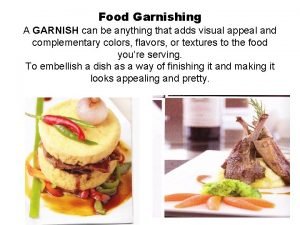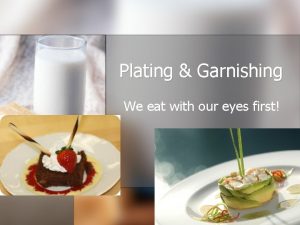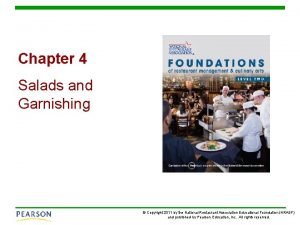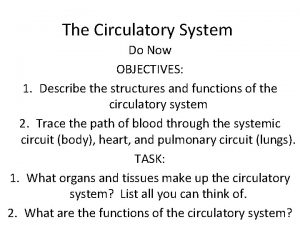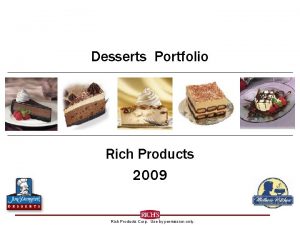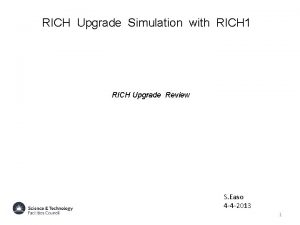Easy Growth Through Garnishing White Paper Rich Products













- Slides: 13

Easy Growth Through Garnishing White Paper Rich Products Corporation One Robert Rich Way Buffalo, NY 14213 (716)878 -8000 June 2002

Executive Summary Few foodservice operators would argue that garnishing enhances a dish. What’s not known are the specifics: In what way does garniture make a dish more desirable, how does that enhancement affect customers’ behavior, and how does their behavior affect an operator’s business? This official research report, or white paper, examines the ability of a garnish to increase the appeal and perceived value of sweet dishes—specifically, desserts, breakfast items and beverages. It also explores the potential benefits of that enhancement to the foodservice operator. Introduction: The Challenge The desire for growth is the common denominator that unites the diverse segments of the foodservice industry. The school foodservice director may aim to increase participation, while the mom-and-pop shop could focus on drawing more traffic. But all operations look for ways to create a stronger business based on a better bottom line. Every industry faces a unique set of obstacles in the pursuit of growth. For foodservice, the challenges stem primarily from the increasing competition for the consumers’ food dollars. No operator would bemoan the expansion of foodservice. As life’s pace speeds up, Americans are left with little time to cook. Eating out has become a necessity, a trend that presents operators with a large, hungry audience. Industry growth has outpaced demand, though, and there are now more seats to fill than customers to fill them. This is a boon for consumers, who can choose from an unprecedented number and variety of foodservice outlets, but a bane for operators, who must differentiate themselves in a crowded marketplace. Food retailers are intensifying the competition for share of stomach. Finally recognizing Americans’ desire for convenient meal solutions, supermarkets and c-stores are sprucing up the fare in their delis and bakeries. Today, they’re offering what once were the exclusive hallmarks of foodservice: a combination of speed, freshness and variety. Other factors besides competition conspire against growth. Finding, training and retaining workers is expensive and time-consuming. The industry’s high turnover rates exacerbate another industry issue, food safety. Operators expend considerable resources training employees in proper food handling. And rightly so. Foodborne diseases cause millions of illnesses every year, according to the Centers for Disease Control and Prevention. Growth Strategies If obstacles to growth abound, so do means of facilitating growth. Common business-building strategies include: Cutting costs. By reducing expenses, operators can drive a larger portion of sales to the bottom line. Energy conservation efforts can trim utility bills; eliminating expensive, low-margin ingredients can bring food costs in lines; and streamlining food prep with convenience products can reduce labor expenses. The challenge here is to increase efficiency without diminishing the dining experience. Unit expansion. Additional units can extend reach into new locations, thereby increasing customer volume and sales. But new units require considerable capital outlay. What’s more, multiple units are less nimble than a single unit in terms of operational or menu changes, so maintaining store-to-store consistency—and customer loyalty—can be difficult. And some would argue with the logic of further clogging a crowded market.

Driving same-store sales. Alternately, operators can drive traffic at their existing locations. A pizza parlor, for example, might add a kids’ menu to draw a new demographic, families with children. To increase current customer’s visits, that pizza place might offer more variety (additional pizza toppings) or value (specially priced breadsticks on the side). To mine slow dayparts, that same dinner-oriented restaurant might introduce breakfast pizzas. And the judicious use of couponing or loyalty programs can draw value-driven customers old and new. Excessive discounting, though, cuts into profits and poses a threat to the perceived value of the brand. Building check averages. Ticket-building can take two forms. Customers may be encouraged to trade up to pricier, higher-margin items—from a basic coffee drink, for example, to a generously garnished deluxe one. Or they may be encouraged to order additional items, frequently from the appetizer, dessert and beverage menus. Ticket-building requires more effort—but is more effective—than simply raising prices. Customers will pay more if they feel they’re getting more. Well-crafted trade-up and add-on items provide the extra value that justifies the added expense. A Growth Tool: Garnishing Most foodservice professionals think of a garnish as a nice added touch, not as an instrument of growth. In fact, a garnish is both. First, some definitions. A garnish is any decorative embellishment to a finished dish, one that’s visually appealing and whose flavor and texture mesh with that of the dish it’s accompanying. Garnishes vary in style, from braided chives to sparklers. But perhaps the most ubiquitous and universally recognized of garnishes is the dollop of whipped topping. The whipped topping garnish serves as the focus of this white paper, not only for its familiarity, but also for its relevance. whipped topping is appropriate for all operations, regardless of concept style or labor situation. It’s applicable atop countless dishes across a number of menuparts, including dessert, breakfast and beverages. It’s the garnishing archetype, offering the most menuing possibilities for the greatest number of foodservice operators. The whipped topping garnish is an “added touch” in more than one sense. It adds texture, color and flavor to the food or beverage item; it adds volume that makes the plate or glass look fuller; and it adds polish to the presentation. The sum effect is a dish that looks more desirable and worthy of a higher asking price. This ability to increase perceived value makes garnishing a powerful tool, one that can help an operator achieve many of the aforementioned growth imperatives—stronger traffic, higher check averages, better margins, operation differentiation. At the same time, it helps manage obstacles like labor and cost-control. whipped topping costs just pennies a serving and is quick and easy to apply. Adding a dollop to a dish takes, literally, seconds. The resulting benefits: Food and labor costs are minimized, and consistent results are easily achieved, even in the hands of unseasoned workers. Stable toppings provide additional advantages. Buffalo, New York-based Rich Products, for example, offers highly stable non-dairy products, including Rich’s® Whip Topping®non-dairy topping and Rich’s® On Top® non-dairy dessert topping, that can be applied in advance and won’t weep or separate over time. This stability lends itself to longlasting displays on dessert trays or carts and can improve kitchen efficiency—the topping can be applied during kitchen downtime, dishes are ready to go during rush periods.

How Garnishes Build Business The simplicity of the whipped topping garnish belies its broad-reaching revenue-generating potential in terms of building sales and traffic. A generous dollop of whipped topping makes a dish look bigger, more indulgent, more special. The customer who sees such a dish is more likely to order it, whether it’s part of a dessert display, as it’s paraded through the dining room on its way to another table, or featured in four-color photography on the menu or in advertising. And one order begets more orders, as others at the table succumb to dessert “peer pressure. ” Finally, the customer who receives such a dish reads “value, ” so he’s more likely to leave the restaurant satisfied and more likely to come back again. Most operators can find a number of opportunities to employ the power of whipped topping on their existing menus. The garnish can be especially effective in promoting new dishes, bolstering efforts of operators trying to make forays into underutilized dayparts or untapped demographics. A new breakfast menu designed to build a morning crowd, for example, can meet with initial hesitancy as customers rearrange their perception of the operation. A whipped topping garnish, so familiar and comforting, can break down resistance to that new breakfast menu, helping an operator sell more pancakes and waffles at a formerly lunch-focused restaurant. In a similar vein, a whipped topping garnish invites trial of a new kids’ menu or new beverage/snacking menu, adding the wow factor that wins over children and the indulgence factor snackers and dessert lover’s crave. A whipped topping garnish can raise check average in two ways. First, a customer who’s on the fence about ordering a dish is more likely to give in when he sees a decadent, generous-looking portion on a display or pictured on the menu or a table tent—an incremental sale that may have been missed if the dessert were not so tempting. Second, garnished items warrant a higher asking price than ungarnished, providing operators with the opportunity to increase their upcharge. The halo effect of garnishing should not be underrated. Consciously or subconsciously, customers notice the fine points. whipped topping garnishes imply an attention to detail that elevates and differentiates both the meal and the establishment where it’s served. The result is a more memorable experience, one that fosters positive word of mouth, better tips and more repeat visits. Support: Two Studies Two studies bear out the axiomatic value of the whipped topping garnish and quantify the effect of the garnish on consumer perceptions and buying behavior. In both studies, consumers were asked to visually evaluate a number of dishes garnished with various sizes of whipped topping dollops. The results of both studies demonstrate that a whipped topping garnish heightens the appeal and perceived value of a dish. Specifically, the study shows that: • consumers overwhelmingly prefer the appearance of a garnished dish • consumers are willing to pay significantly more for a garnished dish • as the size of the dollop increases, so does the perceived value of the dish

Dessert Any investigation of the effects of garnishing with whipped topping would logically start with desserts. This section of the menu is well-recognized as a source of add-on sales. whipped topping is an effective sales tool, one that provides the value and visual appeal that helps persuade customers to “add on” a dessert to the meal. But more to the point, a whipped topping garnish has a natural affinity with this category. Virtually every dessert lends itself to such embellishment—pie, pudding, gelatin desserts, dessert bars, parfaits, cake—and it’s generally assumed that the garnish enhances these dishes in some way. A 1999 study, conducted by GBA Sourcelink for Rich Products Corporation, supports that assumption and provides detailed insight into why and how much. In the study, 163 consumers were shown four servings of pie, each garnished as follows: one with no garnish one with a ¼-ounce garnish one with a ¾-ounce garnish one with a 1 -ounce garnish The consumers were asked to visually evaluate the four samples in two respects: overall appearance and the price they would be willing to pay. They were also asked to choose the sample they preferred the most of the four. The results indicate that customers overwhelmingly prefer garnished desserts over ungarnished ones and they’re willing to pay for the difference. Pie Slice Highlights • In a ranking of visual preference, the pie with the 1 -ounce dollop placed first (47% selected it as their favorite) while the ungarnished placed last (less than 1% preferred this sample). • 70% said they “liked” the pie with the 1 -ounce dollop of topping. • When asked how much they would be willing to pay for the desserts, the price jumped 36%, from an average of $1. 25 for the ungarnished pie to $1. 70 for the pie with the 1 -ounce dollop. “How Much Would You Pay For This Slice of Pie? ”

That 36% increase in asking price equals $. 32 in additional profit per dish, which can potentially add up to hundreds or even thousands of dollars in additional profit over the course of a year. Financial Implications Lower. Volume Operation Price of pie slice garnished with 1 -ounce dollop: Price of ungarnished pie slice $1. 70 --$1. 25 Additional revenue: Average cost of 1 -ounce dollop: $0. 45 --$0. 13 Higher. Volume Operation Additional profit: Pie slices sold per week: $0. 32 x 50 $0. 32 x 100 Additional profit per week: weeks per year $16. 00 x 52 $32. 00 x 52 Additional profit per year $832. 00 $1, 664. 00 As the above chart clearly indicates, a whipped topping garnish has the potential to improve margins. But it’s important to note that the garnish also can improve sales, because success builds on success. When one customer orders dessert, others in the party are more likely to do the same; when those generously garnished, eye-catching desserts are presented at the table, surrounding customers are more likely to “join the crowd” and order dessert as well.

Breakfast A similar study was conducted in the fall of 2001 to measure the effect of a whipped topping garnish on breakfast dishes. Breakfast accounts for the smallest share of foodservice traffic. Americans consumed, on average, almost one commercially prepared breakfast per week in 2000, according to the National Restaurant Association, vs. 2. 1 lunches and 1. 4 dinners. But in the first quarter of 2001, morning traffic jumped 9%, the most rapid growth of all dayparts. The morning meal is generally an under-tapped daypart and responsive to sales-boosting efforts. Dishes like pancakes, waffles, French toast, fresh fruit and breakfast parfaits are complemented by garnishing with whipped topping. The 2001 garnish study measured the effects of whipped topping on two breakfast dishes: pancakes with blueberry topping and fresh sliced fruit. It was prepared by GBA Sourcelink for Rich Products Corporation and conducted with 231 consumers in three markets: Atlanta, Chicago and Los Angeles. In the study, participants were shown four sample dishes. As in the 1999 study, each dish was garnished as follows: one with no garnish one with a ¼-ounce garnish one with a ¾-ounce garnish one with a 1 -ounce garnish The consumers were asked to visually evaluate the four samples in the same two respects as the ’ 99 study, i. e. , overall appearance and the price they would be willing to pay. Again, they were also asked to choose the sample they preferred the most of the four. The results echo the findings of the earlier study, to wit: A whipped topping garnish boosts both appeal and perceived value. Pancake Highlights • In a ranking according to preference, the pancakes with the 1 -ounce dollop placed first (72% chose this as their favorite) and the ungarnished placed last (only 1% chose this as their favorite). • 89% said they “liked” the pancakes with the 1 -ounce dollop. • When asked how much they would be willing to pay for the pancakes, the average price jumped over 41%, from $2. 19 for the ungarnished pancakes to $3. 10 for the pancakes with the 1 -ounce garnish. “How Much Would You Pay For These Pancakes? ”

Financial Implications Lower. Volume Operation Price of pancakes garnished with 1 -ounce dollop: Price of ungarnished pancakes $3. 10 --$2. 19 Additional revenue: Average cost of 1 -ounce dollop: $0. 91 --$0. 13 Additional profit: Pancakes sold per week: Higher. Volume Operation $0. 78 x 50 $0. 78 x 100 Additional profit per week: weeks per year $39. 00 x 52 $78. 00 x 52 Additional profit per year $2, 028. 00 $4, 056. 00 The return on investment here is dramatic. A whipped topping garnish requires minimal cost, labor time or skill, yet can yield a dramatic increase in profit over the course of a year.

Fresh Fruit Highlights • In a ranking according to preference, the fruit with the 1 -ounce garnish placed first (80% chose as most preferred); the ungarnished fruit placed last (3% chose as most preferred). • 93% of the respondents said they “liked” the sliced fruit with the 1 -ounce garnish. • When asked how much they would pay for each dish, the average price jumped 77%, from $1. 14 for the ungarnished fruit to $2. 02 for the fruit with the 1 -ounce garnish. “How Much Would You Pay For This Fruit? ” Financial Implications Lower. Volume Operation Price of fruit garnished with 1 -ounce dollop: Price of ungarnished fruit $2. 02 --$1. 14 Additional revenue: Average cost of 1 -ounce dollop: $0. 88 --$0. 13 Higher. Volume Operation Additional profit: fruit sold per week: $0. 75 x 50 $0. 75 x 100 Additional profit per week: weeks per year $37. 50 x 52 $75. 00 x 52 Additional profit per year $1, 950. 00 $3, 900. 00

Beverages The 2001 study also measured the effect of whipped topping garnish on the profit-laden beverage category. Garnishing opportunities abound when you consider the many varieties of popular smoothies as well as today’s myriad coffee offerings—cold coffee drinks, frozen coffee drinks, lattes, mochas, cappuccinos. The comfort food phenomenon, meantime, has sustained the popularity of two perennial and often-garnished favorites, milkshakes and hot chocolate. The study measured the effects of a whipped topping garnish on these last two beverages, hot chocolate and milkshakes. Not unexpectedly, the results indicate a strong preference for garnished beverages and a willingness to pay more for the drink as the size of the garnish increases. Hot Chocolate Highlights • In a ranking of visual preference, the hot chocolate with the 1 -ounce dollop placed first (85% selected it as their favorite) while the ungarnished placed last (4% preferred this sample the most). • 93% said they “liked” the hot chocolate with the 1 -ounce dollop of topping. • When asked how much they would be willing to pay for the hot chocolate, the price jumped 136%, from an average of $. 93 for the ungarnished drink to $2. 20 for the drink with the 1 -ounce dollop. “How Much Would You Pay For This Hot Chocolate? ”

Financial Implications Lower. Volume Operation Price of hot chocolate garnished with 1 -ounce dollop: Price of ungarnished hot chocolate Additional revenue: Average cost of 1 -ounce dollop: Higher. Volume Operation $2. 20 --$. 93 $1. 27 --$0. 13 Additional profit: Hot chocolate sold per week: $1. 14 x 50 $1. 14 x 100 Additional profit per week: weeks per year $57. 00 x 52 $114. 00 x 52 Additional profit per year $2, 964. 00 $5, 928. 00 The rise in garnished hot chocolate’s perceived value is striking; the price consumers are willing to pay jumped 136% with the addition of a 1 -ounce dollop. This increased value yields an equally striking return—almost $6, 000 in incremental profit for a higher-volume operation.

Milkshake Highlights • In a ranking of visual preference, the shake with the 1 -ounce dollop placed first (78% selected it as their favorite) while the ungarnished placed last (2% preferred this sample the most). • 95% said they “liked” the milkshake with the 1 -ounce dollop of topping. • When asked how much they would be willing to pay for the milkshake, the price jumped 65%, from an average of $1. 53 for the ungarnished shake to $2. 53 for the shake with the 1 -ounce dollop. “How Much Would You Pay For This Milkshake? ” Financial Implications Lower. Volume Operation Price of milkshake garnished with 1 -ounce dollop: Price of ungarnished milkshake $2. 53 --$1. 53 Additional revenue: Average cost of 1 -ounce dollop: $1. 00 --$0. 13 Higher. Volume Operation Additional profit: milkshakes sold per week: $0. 87 x 50 $0. 87 x 100 Additional profit per week: weeks per year $43. 50 x 52 $87. 00 x 52 Additional profit per year $2, 262. 00 $4, 524. 00

What Consumers Said The participants of both studies were asked to explain why they chose the items garnished with generous dollops of whipped topping. Their answers cover various areas of menu presentation—better plate coverage, improved sensory appeal—but overwhelmingly their answers focus on value, a key driver of today’s consumer. It’s important to remember that “value” doesn’t mean consumers want to spend the least amount of money; it means consumers want to be satisfied relative to what they spent. Plate coverage “More topping makes the glass look more full. ” “Enough for every bite!” Improved Sensory Appeal “Looks more appetizing. ” “Looks fresh and rich. ” “Topping adds to the appearance of the drink. ” Overall Greater Pull “More desirable. ” Money’s Worth “More for your money. ” “Feel like I’m getting my money’s worth. ” “Looks like you get more for your money. ” “Bigger is better. ” “The more topping, the better. ” Conclusion: Garnishing Equals Growth A whipped topping garnish is a powerful tool in the pursuit of sales and profit growth. Arguably, no other businessbuilding tactic provides such a compelling combination of benefits (stronger traffic, higher check averages, better margins, operation differentiation, improved customer satisfaction) and operational advantages (ease, speed, affordability) to so many foodservice segments. Operators who currently garnish with whipped topping might want to increase the size of their dollops to achieve the maximum consumer perceived value, the best margins and the biggest profits. Operators who garnish only desserts might want to extend the power of the dollop to tap the breakfast daypart and popular and growing beverage category. Those who are not now garnishing with whipped topping would do well to begin experimenting with the dollop and measuring its effect on their bottom line.
 Identify the tools used for garnishing
Identify the tools used for garnishing Food garnishing techniques
Food garnishing techniques What is the thickest and most stable emulsified dressing?
What is the thickest and most stable emulsified dressing? Plating and garnishing
Plating and garnishing Chapter 4 salads and garnishing
Chapter 4 salads and garnishing Examples of deductive reasoning
Examples of deductive reasoning Every quiz has been easy therefore the quiz will be easy
Every quiz has been easy therefore the quiz will be easy Deductive reasoning
Deductive reasoning Blood flow through the heart easy
Blood flow through the heart easy Functional products
Functional products Pepsi marketing mix
Pepsi marketing mix Plant growth analysis
Plant growth analysis Monocot vs eudicot
Monocot vs eudicot Growthchain
Growthchain

